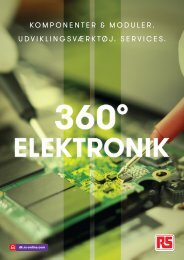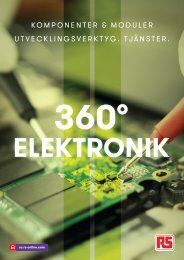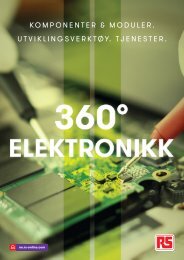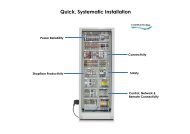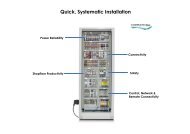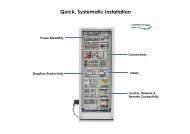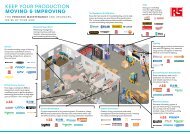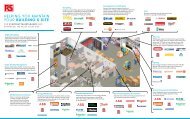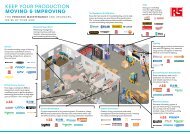Helping You Maintain Your Building and Site - RS IE
For maintaining and improving buildings and sites, find the latest products and services from RS Components. Plus, our feature article discusses how future buildings are becoming even more connected and greener!
For maintaining and improving buildings and sites, find the latest products and services from RS Components. Plus, our feature article discusses how future buildings are becoming even more connected and greener!
You also want an ePaper? Increase the reach of your titles
YUMPU automatically turns print PDFs into web optimized ePapers that Google loves.
Work smart<br />
solving electrical problems<br />
with thermal imaging<br />
Point one: loading<br />
The electrical equipment being inspected must<br />
be under at least 40% of nominal load in order to<br />
detect problems with a thermal imager. Maximum<br />
load conditions are ideal, if possible.<br />
Today’s thermal imagers are rugged, easy to use, <strong>and</strong> much more<br />
affordable than even just a few years ago. They have become a<br />
realistic solution for everyday electrical maintenance.<br />
To use, a qualified technician or electrician points the thermal imager at the<br />
equipment in question <strong>and</strong> scans the immediate area, looking for unexpected hot<br />
spots. The imager produces a live image of the heat emitted from the equipment <strong>and</strong><br />
with the quick squeeze of the trigger, a thermal image is captured. Captured images<br />
can reveal a problem in isolation, or by being compared to a previous image of the<br />
same installation, which may reveal a change over time.<br />
Point two: emissivity<br />
Emissivity describes how well an object emits<br />
infrared energy, or heat. This affects how well<br />
a thermal imager can accurately measure the<br />
object’s surface temperature. Different materials<br />
emit infrared energy in different ways.<br />
Troubleshooting electrical systems<br />
Three-phase imbalance<br />
Capture thermal images of all electrical panels<br />
<strong>and</strong> other high-load connection points such as<br />
drives, disconnects, controls, <strong>and</strong> so on. Wherever<br />
you discover higher temperatures, follow that<br />
circuit <strong>and</strong> examine associated branches <strong>and</strong><br />
loads. Compare all three phases side-byside<br />
<strong>and</strong> check for temperature differences. A<br />
cooler-than-normal circuit or leg might signal<br />
a failed component. More heavily loaded<br />
phases will appear warmer. Hot conductors<br />
may be undersized or overloaded. However, an<br />
unbalanced load, an overload, a bad connection,<br />
<strong>and</strong> harmonics can all create a similar pattern,<br />
so follow up with electrical or power quality<br />
measurements to diagnose the problem.<br />
Connections <strong>and</strong> wiring<br />
Look for connections that have higher<br />
temperatures than other similar connections under<br />
similar loads. That could indicate a loose, over<br />
tightened, or corroded connection with increased<br />
resistance. Connection-related hot spots usually,<br />
but not always, appear warmest at the spot of<br />
resistance, cooling with distance from that spot.<br />
In some cases a cold component is abnormal due<br />
to the current being shunted away from the highresistance<br />
connection. <strong>You</strong> may also find broken<br />
or undersized wires or defective insulation.<br />
Fuses<br />
If a fuse shows up hot on a thermal scan, it may<br />
be at or near its current capacity. However, not<br />
all problems are hot. A blown fuse, for example,<br />
would produce a cooler than normal temperature.<br />
Motor control centers (MCC)<br />
To evaluate an MCC under load, compare the<br />
relative temperatures of key components: bus<br />
bars, controllers, starters, contactors, relays,<br />
fuses, breakers, disconnects, feeders, <strong>and</strong><br />
transformers. Incorporate the guidelines above<br />
for inspecting connections, fuses <strong>and</strong> identifying<br />
phase imbalance.<br />
Transformers<br />
For oil-filled transformers, use a thermal imager<br />
to look at high- <strong>and</strong> low-voltage external bushing<br />
connections, cooling tubes, <strong>and</strong> cooling fans<br />
<strong>and</strong> pumps, as well as the surfaces of critical<br />
transformers. Keep in mind that like an electric<br />
motor, a transformer has a maximum operating<br />
temperature that represents the maximum<br />
allowable rise in temperature above ambient.<br />
24<br />
25






